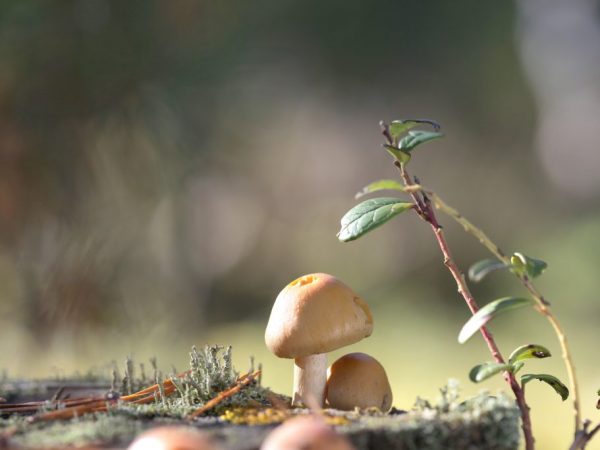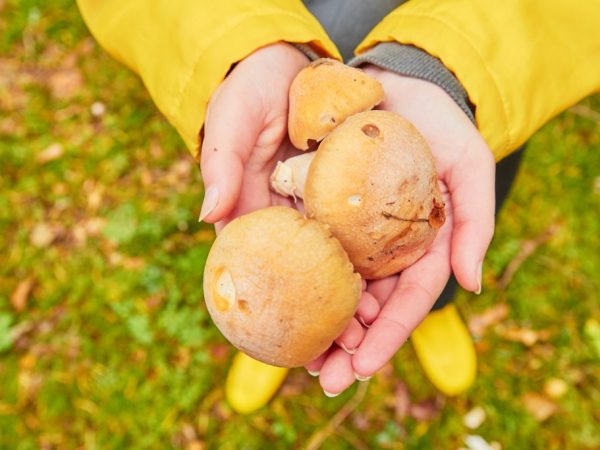Description of the mushroom ringed cap
The ringed cap is a mushroom, which in Europe is valued on a par with champignon for its taste. In our country, mushrooms "chicken" (as the caps are called) are neither widespread nor recognized. They are collected only by experienced mushroom pickers. The description of the "chickens" will help you not to make mistakes during collection and preparation.

Description of the mushroom Ringed cap
Description of the mushroom
The ringed mushroom is a lamellar mushroom. There are several names for this variety: rosites, Turk, pribolotnik, "cockerels" (brilliant green), "gusochki". Gray rows are also sometimes mistakenly called "chickens".
The description will help to recognize the cockerel and distinguish it from the poisonous varieties:
- the cap of a young mushroom is ovoid or spherical, the edges are adjacent to the stem;
- the color of the hat is pinkish-brown, reminiscent of the color of the shell of chicken eggs;
- the diameter of the cap of young creepers is 4-4.5 cm, of adults - 9-11 cm;
- the leg is cylindrical at the base, slightly swollen;
- the plates of young mushrooms are yellowish; as the spores mature, they darken to a rusty color.
As the fish grows, the shape of its cap changes. A hump appears in the center, the edges diverge to the sides, a "skirt" made of a torn film remains on the leg. Over time, the "skirt" dries up, only the rim remains on the leg. The edges of the cap also dry out and crack over time, the cracks go to the center. Spores of an adult fungus leave an ocher-colored coating on the hands.
The hat of the chickens is wrinkled, covered with a white powdery coating (especially in the central part). The similarity to the fly agaric is also given by the leg extended at the base. However, rosites lack a cover (volva) around the thickening.
Rozites grow in pine and mixed forests, near bogs in the Leningrad region. Collecting caps begins in the middle of summer (after July 10) before the first autumn frosts. They form groups, sometimes grow in circles, which our ancestors called "witches".
Irina Selyutina (Biologist):
The edible ringed cap chose mixed and pine forests as its habitat, much less often this species can be found in oak forests. In the northern part of the species range, the cap can also be found under dwarf birches. They are characterized by the formation of mycorrhiza with conifers, birches and, less often, oaks. He prefers acidic and moist soils, so if there are blueberries in your forest, you can try to look for a ringed cap there. If there is a large amount of moss in the pine forest, then it is worth looking there too.
Mushrooms grow in small groups from July to October in Central and Western Russia.

The hat is wrinkled, it is covered with a white coating, which becomes scales at the edges
Poisonous mushrooms
The ringed cap can be easily confused with the cobweb. Spiderwebs are a genus, most of which are poisonous. They also have a buffy spore powder and many of the "female" appearance. It is better to go after the guards in the company of an experienced mushroom picker.
Irina Selyutina (Biologist):
In appearance, the ringed cap is similar to some types of poisonous mushrooms. However, upon careful and thoughtful examination, one can see serious differences.
The cap is often confused with the fly agaric. This mushroom can be distinguished by its following characteristic features:
- mealy bloom on the cap;
- lack of whitish scales on the cap;
- lack of a Volvo;
- ocher color of spore powder;
- the color of the plates is rusty-brown (close to ocher).
They can also confuse the ringed cap with cobwebs, most of the species of which are poisonous. Here it is important to pay attention to the absence of a cobweb blanket (protecting the spore-bearing layer) between the stem and the cap - the cap has no spider-web-like remnants on the stem.
The group of edible caps often includes false mushrooms, pale toadstools, and white fly agarics. It is important to carefully examine and sniff each one during collection. A distinctive feature of toxic fungi is the white color of the plates, which does not change with age.
Beneficial features
The annular cap contains amino acids, enzymes, vitamins, valuable minerals in the pulp. It has such beneficial properties as:
- increases the body's resistance to infections;
- reduces the harmful effects of free radicals;
- calms the nervous system;
- increases stress resistance;
- improves digestion.
Only real edible ringed caps are beneficial. It is important to collect and prepare them correctly.

Contains amino acids, enzymes, vitamins and minerals in the pulp
Contraindications
The ringed cap is not useful for everyone. It must not be consumed:
- small children;
- pregnant and lactating women;
- sick with an ulcer or gastritis;
- patients with renal or hepatic insufficiency.
Caps, like any other edible mushrooms collected near the highway, a large industrial enterprise, a garbage dump, are strictly forbidden to eat. The hoods quickly accumulate toxins from the environment. Symptoms of intoxication - nausea, vomiting, headache, frequent diarrhea, cutting pain in the abdomen.
Application
The pleasant taste and smell of the Turks, as well as the unique nutritional composition, allows them to be widely used in cooking. It is recommended to process only freshly harvested rosites.
In folk medicine, podolotniki are not used. This is due to their low popularity among the population.
Cooking use
Chicken mushrooms, like champignons, are eaten in different forms. "Chickens" are salted, pickled, fried, stewed, added to soups, meat dishes, salads, and sauces are prepared on their basis. Mushrooms frozen for the winter retain all their beneficial properties.
This mushroom is considered a delicacy in European countries. For the preparation of various dishes, the same caps are usually used, removing the hard legs. Prepare them after preliminary boiling.
Before preparing the dish, the collected podolotniks are shaken off the ground, washed under running water, boiled in filtered water for 15-25 minutes.
Conclusion
To collect only healthy and tasty chicken mushrooms, you need to carefully study their description. You can not eat podolotniki if you have certain contraindications. If the quality of the mushrooms and their edibility are in doubt, they cannot be harvested and consumed even boiled.


